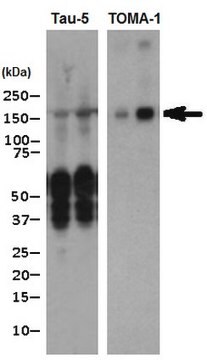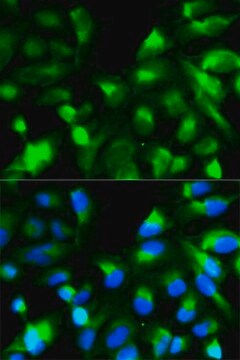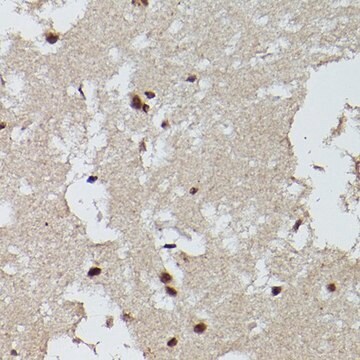MABN471
Anti-Tau Antibody, PAD, clone TNT-1
clone TNT-1, from mouse
Synonim(y):
Microtubule-associated protein tau, Neurofibrillary tangle protein, Paired helical filament-tau, PHF-tau, Tau
About This Item
Polecane produkty
pochodzenie biologiczne
mouse
Poziom jakości
forma przeciwciała
purified antibody
rodzaj przeciwciała
primary antibodies
klon
TNT-1, monoclonal
reaktywność gatunkowa
mouse, rat, human
metody
ELISA: suitable
dot blot: suitable
immunofluorescence: suitable
immunohistochemistry: suitable
western blot: suitable
izotyp
IgG1κ
numer dostępu NCBI
numer dostępu UniProt
Warunki transportu
wet ice
docelowa modyfikacja potranslacyjna
unmodified
informacje o genach
human ... MAPT(4137)
mouse ... Mapt(17762)
rat ... Mapt(29477)
Opis ogólny
Immunogen
Zastosowanie
Neuroscience
Neurodegenerative Diseases
Immunohistochemistry Analysis: A 1:2,000 dilution from a representative lot detected Tau, PAD in human Alzheimer′s brain tissue.
Immunohistochemistry Analysis: A representative lot from an independent laboratory detected Tau, PAD in normal and Alzheimer′s tissues from entorhinal cortex, hippocampus, inferior temporal gyrus, and superior gyrus of control (Kanaan, N. M., et al. (2011). J Neurosci. 31(27):9858-9868.).
ELISA Analysis: A representative lot from an independent laboratory detected Tau, PAD in recombinant Tau protein (Kanaan, N. M., et al. (2011). J Neurosci. 31(27):9858-9868.).
Jakość
Western Blot Analysis: 1 µg/mL of this antibody detected Tau, PAD in 10 µg of rat cortex tissue lysate.
Opis wartości docelowych
Powiązanie
Postać fizyczna
Przechowywanie i stabilność
Komentarz do analizy
rat cortex tissue lysate
Inne uwagi
Oświadczenie o zrzeczeniu się odpowiedzialności
Not finding the right product?
Try our Narzędzie selektora produktów.
Kod klasy składowania
12 - Non Combustible Liquids
Klasa zagrożenia wodnego (WGK)
WGK 1
Temperatura zapłonu (°F)
Not applicable
Temperatura zapłonu (°C)
Not applicable
Certyfikaty analizy (CoA)
Poszukaj Certyfikaty analizy (CoA), wpisując numer partii/serii produktów. Numery serii i partii można znaleźć na etykiecie produktu po słowach „seria” lub „partia”.
Masz już ten produkt?
Dokumenty związane z niedawno zakupionymi produktami zostały zamieszczone w Bibliotece dokumentów.
Nasz zespół naukowców ma doświadczenie we wszystkich obszarach badań, w tym w naukach przyrodniczych, materiałoznawstwie, syntezie chemicznej, chromatografii, analityce i wielu innych dziedzinach.
Skontaktuj się z zespołem ds. pomocy technicznej








